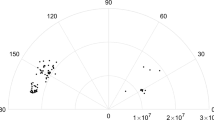Abstract
This paper presents the crucial method for obtaining our team’s results in the 8th Global Trajectory Optimization Competition (GTOC8). Because the positions and velocities of spacecraft cannot be completely determined by one observation on one radio source, the branch and bound method for sequence optimization of multi-asteroid exploration cannot be directly applied here. To overcome this difficulty, an optimization method for searching the observing sequence based on nominal low-thrust trajectories of the symmetric observing configuration is proposed. With the symmetric observing configuration, the normal vector of the triangle plane formed by the three spacecraft rotates in the ecliptic plane periodically and approximately points to the radio sources which are close to the ecliptic plane. All possible observing opportunities are selected and ranked according to the nominal trajectories designed by the symmetric observing configuration. First, the branch and bound method is employed to find the optimal sequence of the radio source with thrice observations. Second, this method is also used to find the optimal sequence of the left radio sources. The nominal trajectories are then corrected for accurate observations. The performance index of our result is 128,286,317.0 km which ranks the second place in GTOC8.
Similar content being viewed by others
Change history
11 February 2022
A Correction to this paper has been published: https://doi.org/10.1007/s42064-022-0136-2
References
Petropoulos, A. E. GTOC8: Problem description and summary of the results. In: Proceedings of the 26th AAS/AIAA Space Flight Mechanics Meeting, 2016.
Bertrand, R., Epenoy, R. New smoothing techniques for solving bang–bang optimal control problems-numerical results and statistical interpretation. Optimal Control Applications and Methods, 2002, 23(4): 171–197.
Olympio, J. T. Optimal control problem for low-thrust multiple asteroid tour missions. Journal of Guidance, Control, and Dynamics, 2011, 34(6): 1709–1720.
Jiang, F., Baoyin, H., Li, J. Practical techniques for low-thrust trajectory optimization with homotopic approach. Journal of Guidance, Control, and Dynamics, 2012, 35(1): 245–258.
Jiang, F., Chen, Y., Liu, Y., Baoyin, H., Li, J. GTOC5: Results from the Tsinghua University. Acta Futura, 2014, 8: 37–44.
Casalino, L. Approximate optimization of low-thrust transfers between low-eccentricity close orbits. Journal of Guidance, Control, and Dynamics, 2014, 37(3): 1003–1008.
Gatto, G., Casalino, L. Fast evaluation and optimization of low-thrust transfers to multiple targets. Journal of Guidance, Control, and Dynamics, 2015, 38(8): 1525–1530.
Yang, H., Li, J., Baoyin, H. Low-cost transfer between asteroids with distant orbits using multiple gravity assists. Advances in Space Research, 2015, 56(5): 837–847.
Petropoulos, A. E., Longuski, J. M. Shape-based algorithm for the automated design of low-thrust, gravity assist trajectories. Journal of Spacecraft and Rockets, 2004, 41(5): 787–796.
Gao, Y., Kluever, C. A. Low-thrust interplanetary orbit transfers using hybrid trajectory optimization method with multiple shooting. In: Proceedings of the AIAA/AAS Astrodynamics Specialist Conference and Exhibit, Guidance, Navigation, and Control and Colocated Conferences, 2004: AIAA 2004-5088.
Petropoulos, A. E., Longuski, J. M., Bonfi glio, E. P. Trajectories to Jupiter via gravity assists from Venus, Earth, and Mars. Journal of Spacecraft and Rockets, 2000, 37(6): 776–783.
Casalino, L., Colasurdo, G. Problem description for the 7th Global Trajectory Optimisation Competition. 2014. Available at http://sophia.estec. esa.int/gtoc portal.
Shen, H.-X., Huang, A.-Y., Zhang, Z.-B., Li, H.-N. GTOC8: Results and methods of State Key Laboratory of Astronautic Dynamics. In: Proceedings of the AAS/AIAA Space Flight Mechanics Meeting, 2016: AAS 16-384.
He, S., Zhu, Z., Gao, Y. GTOC8: Results and methods of TEAM 8/Chinese Academy of Sciences. In: Proceedings of the AAS/AIAA Space Flight Mechanics Meeting, 2016: AAS 16-552.
Tang, G., Yang, H., Jiang, F., Baoyin, H., Li, J. GTOC8: Results and methods of TEAM 3–Tsinghua University. In: Proceedings of the AAS/AIAA Space Flight Mechanics Meeting, 2016: AAS 16-248.
Acknowledgements
This work is supported by the National Natural Science Foundation of China (Grant Nos. 11672146 and 11432001). The authors thank the organizer of GTOC8.
Author information
Authors and Affiliations
Corresponding author
Additional information
Hongwei Yang received his Ph.D. degree in aerospace engineering from Tsinghua University, China, in 2017, and he was a visiting Ph.D. student of Rutgers University, USA, in 2015–2016. His current research interests include dynamics and control near asteroids, interplanetary trajectory design, and optimization.
Gao Tang received his bachelor degree and master degree in aerospace engineering from Tsinghua University, China, in 2010 and 2012, respectively. He is currently pursuing his Ph.D. degree in the Department of Mechanical Engineering and Material Science at Duke University, USA. His current research interests include dynamics and control in robotics, interplanetary trajectory optimization, and global optimization methods.
Fanghua Jiang received his B.S. degree in engineering mechanics and Ph.D. degree in mechanics from Tsinghua University, China, in 2004 and 2009, respectively. Since 2009, he has worked in the School of Aerospace Engineering at Tsinghua University, China, including two years of postdoctor, three years of research assistant, and two years of associate professor up to now. Currently, he is an AIAA senior member. His current research interests include astrodynamics, spacecraft formation ying, and interplanetary trajectory optimization.
Rights and permissions
About this article
Cite this article
Yang, H., Tang, G. & Jiang, F. Optimization of observing sequence based on nominal trajectories of symmetric observing configuration. Astrodyn 2, 25–37 (2018). https://doi.org/10.1007/s42064-017-0009-2
Received:
Accepted:
Published:
Issue Date:
DOI: https://doi.org/10.1007/s42064-017-0009-2



